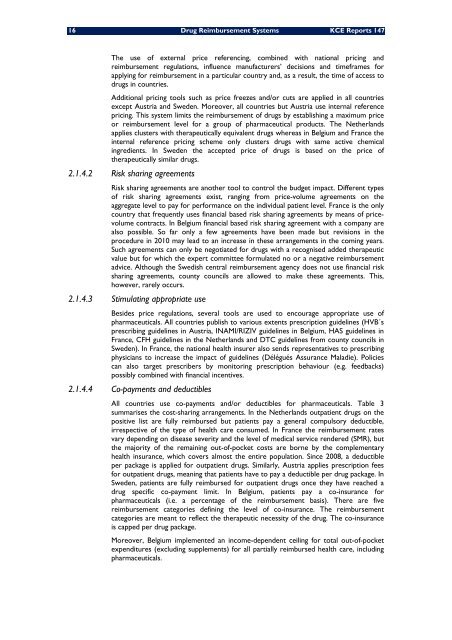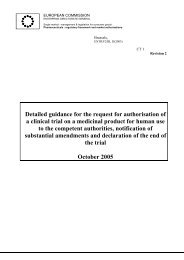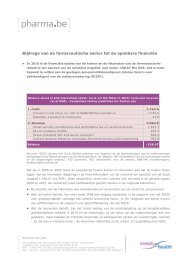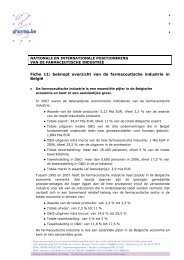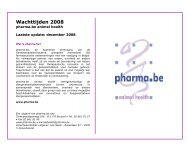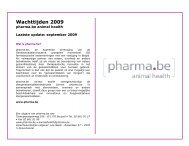Terugbetalingssystemen voor geneesmiddelen ... - Pharma
Terugbetalingssystemen voor geneesmiddelen ... - Pharma
Terugbetalingssystemen voor geneesmiddelen ... - Pharma
- No tags were found...
You also want an ePaper? Increase the reach of your titles
YUMPU automatically turns print PDFs into web optimized ePapers that Google loves.
16 Drug Reimbursement Systems KCE Reports 147<br />
The use of external price referencing, combined with national pricing and<br />
reimbursement regulations, influence manufacturers’ decisions and timeframes for<br />
applying for reimbursement in a particular country and, as a result, the time of access to<br />
drugs in countries.<br />
Additional pricing tools such as price freezes and/or cuts are applied in all countries<br />
except Austria and Sweden. Moreover, all countries but Austria use internal reference<br />
pricing. This system limits the reimbursement of drugs by establishing a maximum price<br />
or reimbursement level for a group of pharmaceutical products. The Netherlands<br />
applies clusters with therapeutically equivalent drugs whereas in Belgium and France the<br />
internal reference pricing scheme only clusters drugs with same active chemical<br />
ingredients. In Sweden the accepted price of drugs is based on the price of<br />
therapeutically similar drugs.<br />
2.1.4.2 Risk sharing agreements<br />
Risk sharing agreements are another tool to control the budget impact. Different types<br />
of risk sharing agreements exist, ranging from price-volume agreements on the<br />
aggregate level to pay for performance on the individual patient level. France is the only<br />
country that frequently uses financial based risk sharing agreements by means of pricevolume<br />
contracts. In Belgium financial based risk sharing agreement with a company are<br />
also possible. So far only a few agreements have been made but revisions in the<br />
procedure in 2010 may lead to an increase in these arrangements in the coming years.<br />
Such agreements can only be negotiated for drugs with a recognised added therapeutic<br />
value but for which the expert committee formulated no or a negative reimbursement<br />
advice. Although the Swedish central reimbursement agency does not use financial risk<br />
sharing agreements, county councils are allowed to make these agreements. This,<br />
however, rarely occurs.<br />
2.1.4.3 Stimulating appropriate use<br />
Besides price regulations, several tools are used to encourage appropriate use of<br />
pharmaceuticals. All countries publish to various extents prescription guidelines (HVB´s<br />
prescribing guidelines in Austria, INAMI/RIZIV guidelines in Belgium, HAS guidelines in<br />
France, CFH guidelines in the Netherlands and DTC guidelines from county councils in<br />
Sweden). In France, the national health insurer also sends representatives to prescribing<br />
physicians to increase the impact of guidelines (Délégués Assurance Maladie). Policies<br />
can also target prescribers by monitoring prescription behaviour (e.g. feedbacks)<br />
possibly combined with financial incentives.<br />
2.1.4.4 Co-payments and deductibles<br />
All countries use co-payments and/or deductibles for pharmaceuticals. Table 3<br />
summarises the cost-sharing arrangements. In the Netherlands outpatient drugs on the<br />
positive list are fully reimbursed but patients pay a general compulsory deductible,<br />
irrespective of the type of health care consumed. In France the reimbursement rates<br />
vary depending on disease severity and the level of medical service rendered (SMR), but<br />
the majority of the remaining out-of-pocket costs are borne by the complementary<br />
health insurance, which covers almost the entire population. Since 2008, a deductible<br />
per package is applied for outpatient drugs. Similarly, Austria applies prescription fees<br />
for outpatient drugs, meaning that patients have to pay a deductible per drug package. In<br />
Sweden, patients are fully reimbursed for outpatient drugs once they have reached a<br />
drug specific co-payment limit. In Belgium, patients pay a co-insurance for<br />
pharmaceuticals (i.e. a percentage of the reimbursement basis). There are five<br />
reimbursement categories defining the level of co-insurance. The reimbursement<br />
categories are meant to reflect the therapeutic necessity of the drug. The co-insurance<br />
is capped per drug package.<br />
Moreover, Belgium implemented an income-dependent ceiling for total out-of-pocket<br />
expenditures (excluding supplements) for all partially reimbursed health care, including<br />
pharmaceuticals.


